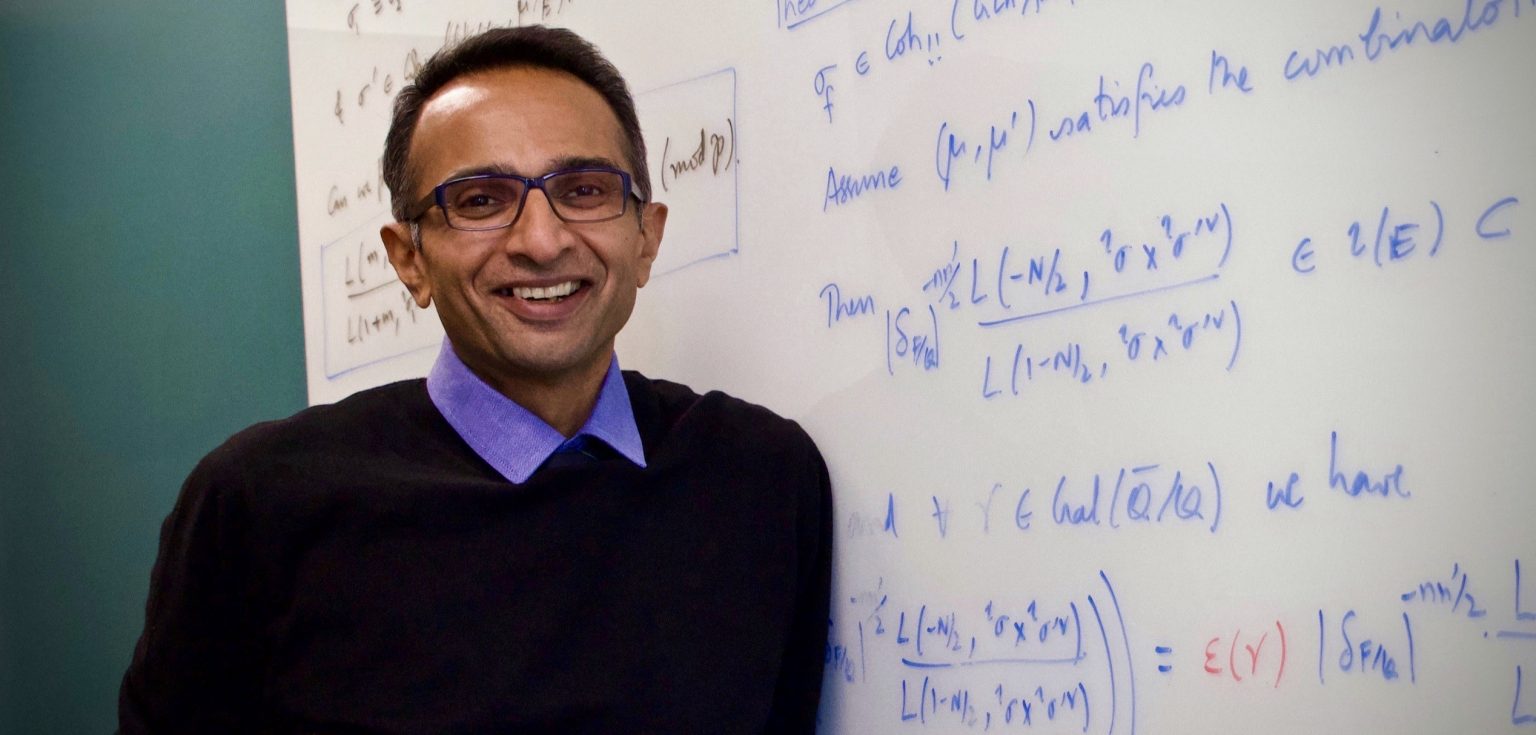“People don’t study number theory because it’s useful,” he said. “They study it because it’s beautiful.”
Raghuram’s research on number theory—a branch of mathematics devoted to the study of natural numbers and integers—has been recognized on an international scale. He has presented his work at the Max Planck Institute for Mathematics in Bonn, Germany, and served as a member of the Institute for Advanced Study in Princeton, New Jersey. His research has been funded by the prestigious Humboldt Research Fellowship in Germany and the National Science Foundation in the U.S.
Raghuram is an accomplished mathematician in the U.S. and in his native India. He earned a bachelor’s degree in computer science and engineering from the Indian Institute of Technology at Kanpur (IITK) and a Ph.D. in mathematics from the Tata Institute of Fundamental Research. After holding postdoctoral positions at the University of Toronto, Purdue University, and the University of Iowa, he joined the faculty at Oklahoma State University, where he was granted tenure in 2011 as an associate professor. He went on to become the first chair of mathematics at the Indian Institute of Science Education and Research at Pune and a distinguished honorary professor at his alma mater, IITK. He is a fellow of the Indian Academy of Sciences and the Indian National Science Academy.
This fall, he joined Fordham’s faculty. In a Q&A with Fordham News, he spoke about his academic journey.
Were you always good at math?
I grew up in a middle-class home in Bengaluru, India. My father was a chemical engineer for India’s space research organization within the rocket propulsion unit. He and my mother emphasized the importance of doing well in school, where I was good at math. In eleventh grade, I won a state mathematics olympiad. I also did well on my entrance exam for competitive science and technology schools across India—I came second in the country. But I didn’t know you could have a career in mathematics.
How did you become a mathematician?
At first, I majored in computer science. All the top-ranked students wanted to study it. Then I realized I enjoyed mathematics more than anything else. A professor mentored me and helped me read the right kinds of books. My parents were opposed to me studying mathematics because a career in computer science pays much more. There is some truth to that. Many of my former classmates are now millionaires who own companies in Silicon Valley. But for many mathematicians like myself, their career is a calling.
In your new role at Fordham, you teach and advise undergraduates. How has that been going?
This semester, I am teaching an intermediate linear algebra course to 23 students, ranging from first-year students to seniors who study mathematics, computer science, economics, and finance. The class size is just right. I can get to know the students on a one-on-one basis. At a public university, I once taught a course with 350 students, and it felt impossible to get to know them all. I also find Fordham an exceptionally friendly place. There’s this idea of New York City being a busy place where people are on the go, with no time for niceties. But Fordham is an antithesis to that.
How would you describe your research?
I try to understand all kinds of patterns within numbers. Sometimes they seem unclear and haphazard. But when you dig deeper, there are all these mysterious patterns. The first time I encountered this was with prime numbers. A number is prime if it has no divisors, like 5, 7, or 11. If you take the set of all prime numbers, you can see all the beautiful patterns that show up.
You rely on prime numbers every time you use a credit card. The numbers in your 16-digit number and security code are encoded in a certain way. The process of taking a number and jumbling it up in a seemingly random way is actually systematic. Without the idea of a prime number, you can’t even get started on this subject.
I don’t know if my research has immediate applications to things like Internet commerce. But who knows? There’s an essay called “The Usefulness of Useless Knowledge” by American educator Abraham Flexner, which says that knowledge drives and creates itself. Fifty years later, someone might realize that what we did is exactly the right tool that’s needed for some physical phenomenon.
I once asked another Fordham math professor what his research process looks like. He said he brainstorms on his sofa. What about you?
There is a little bit of lying on the couch and trying to meditate over the whole thing to see if I can assimilate all these various calculations. I think every mathematician has to meditate—it’s an intrinsic part of the process. But I also fiddle with numbers and equations on paper and on my iPad.
Over the past five years, I’ve been working on a 60-page manuscript for a research paper on number theory. In one section, I needed to prove a technical statement. It took me about six months of hard work and filling in hundreds of pages of calculations until I saw a pattern that explained how those things were behaving.
You helped to produce a documentary about Srinivasa Ramanujan, a pioneering mathematician, that has been screened across hundreds of schools and colleges in India. What was one of the highlights of working on this project?
In the 1890s, Ramanujan grew up in a very poor place in India. Paper was expensive, so he wrote most of his mathematical equations on a small slate with chalk. He would write and erase until he found something worth recording on paper. Those sheets were bound together into three notebooks, now housed in a library. There is one scene in the documentary where another mathematician and I are sitting in the library, going through Ramanujan’s notebooks. Those notebooks are a national treasure.
This interview has been edited and condensed for clarity.


